Integrating Occupational Health and Safety Risk and Production Economics for Sustainable SME Growth
Abstract
:1. Introduction
2. Literature Review
2.1. Plant Simulation
2.2. Occupational Health and Safety Risk Assessment
2.3. Gaps in the Integration of Plant Simulation and OHS Risk Assessment
3. Research Method
3.1. Research Objective
3.2. Research Approach
4. Results of a Bakery Case Study
4.1. Background of the Case Study
4.2. The Status Quo Simulation
4.3. The DQL Assessment in the Simulation
4.4. Productivity Analysis between Status Quo and Scenario No. 2
4.5. Scenarios for System Growth
- Storage space is sufficient and is always available;
- An extra pie-forming machine would cost NZD 10,000, including installation;
- An extra oven employed in the system would cost NZD 10,000, including installation;
- The operation cost of other machines is not considered, because they are the same in different scenarios;
- The profit margin per pie is NZD 0.10;
- 5 skilled workers are always available for pie production;
- A worker is paid NZD 20 per hour;
- The factory operates 300 days a year.
4.6. DQL of Growth Scenarios
5. Discussion
5.1. Contribution of the Work
5.2. Comparison with Other Traditional Methods
5.3. Limitations and Opportunies
6. Conclusions
Author Contributions
Funding
Institutional Review Board Statement
Informed Consent Statement
Data Availability Statement
Acknowledgments
Conflicts of Interest
Appendix A
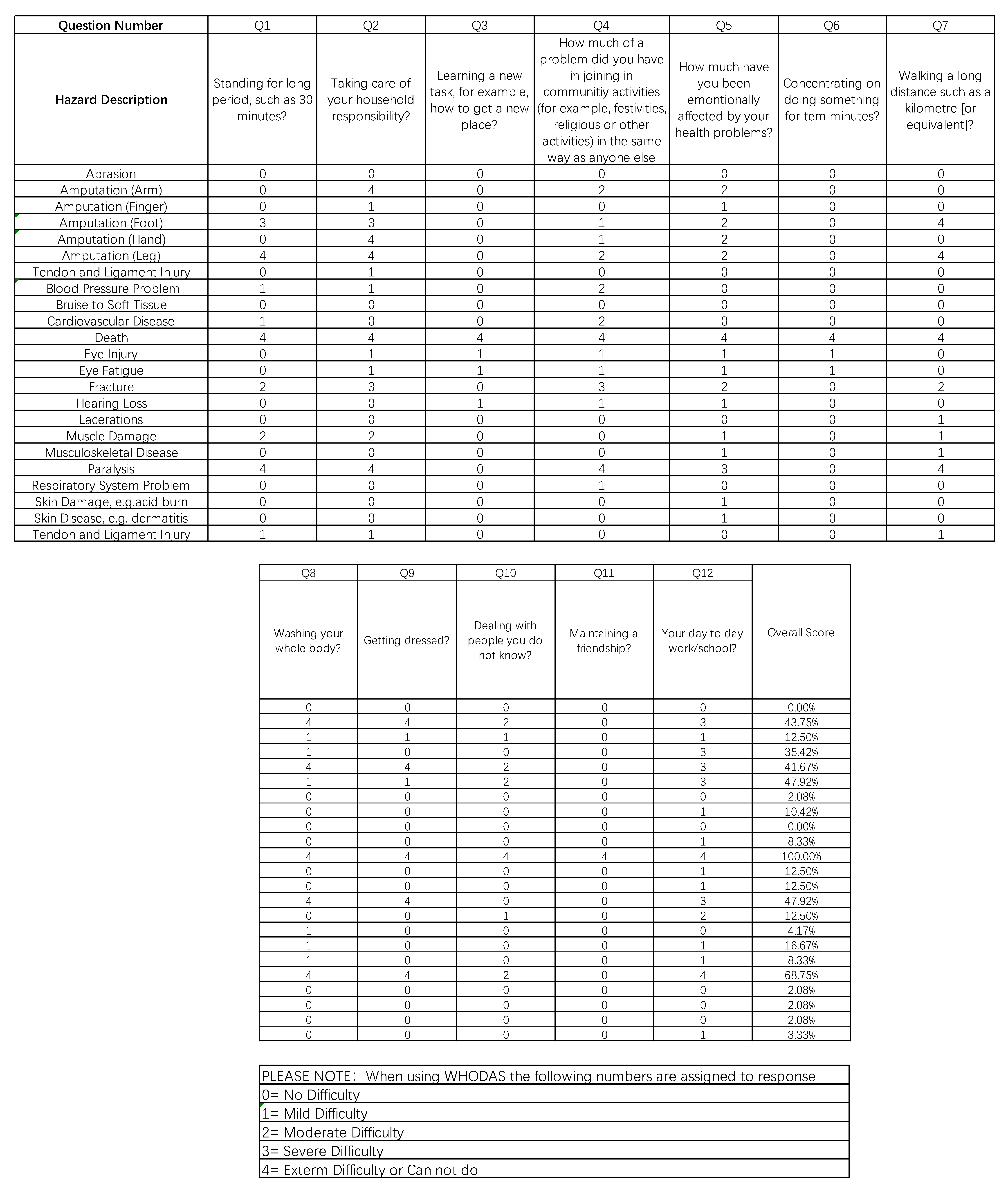
References
- Li, R.Y.M.; Tang, B.; Chau, K.W. Sustainable Construction Safety Knowledge Sharing: A Partial Least Square-Structural Equation Modeling and A Feedforward Neural Network Approach. Sustainability 2019, 11, 5831. [Google Scholar] [CrossRef] [Green Version]
- Kavouras, S.; Vardopoulos, I.; Mitoula, R.; Zorpas, A.A.; Kaldis, P. Occupational Health and Safety Scope Significance in Achieving Sustainability. Sustainability 2022, 14, 2424. [Google Scholar] [CrossRef]
- Yang, K.; Kim, K.; Go, S. Towards Effective Safety Cost Budgeting for Apartment Construction: A Case Study of Occupational Safety and Health Expenses in South Korea. Sustainability 2021, 13, 1335. [Google Scholar] [CrossRef]
- Kikolski, M. Identification of production bottlenecks with the use of Plant Simulation software. Eng. Manag. Prod. Serv. 2016, 8, 103–112. [Google Scholar] [CrossRef] [Green Version]
- Ji, Z.; Pons, D.J.; Pearse, J. Plant system simulation for engineering training workshops. Comput. Appl. Eng. Educ. 2019, 28, 17–30. [Google Scholar] [CrossRef]
- Nemtinov, V.; Nemtinova, Y.; Borisenko, A.; Mokrozub, V. Information support of decision making in urban passenger transport management. Probl. Transp. 2018, 12, 83–90. [Google Scholar]
- Ji, Z.; Yang, S.-H.; Cao, Y.; Wang, Y.; Zhou, C.; Yue, L.; Zhang, Y. Harmonizing safety and security risk analysis and prevention in cyber-physical systems. Process Saf. Environ. Prot. 2021, 148, 1279–1291. [Google Scholar] [CrossRef]
- Greasley, A.; Owen, C. Modelling people’s behaviour using discrete-event simulation: A review. Int. J. Oper. Prod. Manag. 2018, 38, 1228–1244. [Google Scholar] [CrossRef] [Green Version]
- Brito, M.; Ramos, A.; Carneiro, P.; Gonçalves, M. Integration of lean manufacturing and ergonomics in a metallurgical industry. Int. J. Occup. Environ. Saf. 2018, 2, 21–31. [Google Scholar] [CrossRef] [Green Version]
- Peruzzini, M.; Grandi, F.; Cavallaro, S.; Pellicciari, M. Using virtual manufacturing to design human-centric factories: An industrial case. Int. J. Adv. Manuf. Technol. 2021, 115, 873–887. [Google Scholar] [CrossRef]
- Robertson, R.; Beaven, A.; Coolbear, T.; Hill, J.; Kirk, T.; McCullough, G.; Piper, M.; Venter, P. Multi-faceted and holistic risk management for business-critical food-safety events causing major disruption to both small and large businesses—An illustrative model. Food Control 2022, 134, 108714. [Google Scholar] [CrossRef]
- Ji, Z.; Pons, D.; Pearse, J. Measuring Industrial Health Using a Diminished Quality of Life Instrument. Safety 2018, 4, 55. [Google Scholar] [CrossRef] [Green Version]
- Üstün, B.; Kostanjsek, N.; Chatterji, S.; Rehm, J. Measuring Health and Disability: Manual for WHO Disability Assessment Schedule WHODAS 2.0; World Health Organization: Geneva, Switzerland, 2010. [Google Scholar]
- Ji, Z.; Pons, D.J.; Pearse, J. Integrating occupational health and safety into plant simulation. Saf. Sci. 2020, 130, 104898. [Google Scholar] [CrossRef]
- Ji, Z.; Pons, D.; Pearse, J. A Methodology for Harmonizing Safety and Health Scales in Occupational Risk Assessment. Int. J. Enviorn. Res. Public Health 2021, 18, 4849. [Google Scholar] [CrossRef] [PubMed]
- Ji, Z.; Su, H.; Wang, Y.; Cao, Y.; Yang, S. Assessing the Risk of Hazards with Multidimensional Consequences for Industrial Processes. Processes 2022, 10, 1145. [Google Scholar] [CrossRef]
- Murugesan, V.S.; Jauhar, S.K.; Sequeira, A.H. Applying simulation in lean service to enhance the operational system in Indian postal service industry. Ann. Oper. Res. 2022, 315, 993–1017. [Google Scholar] [CrossRef]
- Yang, B.; Yan, X.; Guo, D. Level of Service Analysis Based on Maximum Number of Passengers in Waiting Room of Railway Passenger Station Using Arena Simulation. Discret. Dyn. Nat. Soc. 2015, 2015, 452035. [Google Scholar] [CrossRef] [Green Version]
- Lyu, Z.; Pons, D.; Zhang, Y.; Ji, Z. Freight Operations Modelling for Urban Delivery and Pickup with Flexible Routing: Cluster Transport Modelling Incorporating Discrete-Event Simulation and GIS. Infrastructures 2021, 6, 180. [Google Scholar] [CrossRef]
- Alvanchi, A.; Azimi, R.; Lee, S.; Abourizk, S.M.; Zubick, P. Off-site construction planning using discrete event simulation. J. Archit. Eng. 2012, 18, 114–122. [Google Scholar] [CrossRef]
- Knight, V.A.; Williams, J.E.; Reynolds, I. Modelling patient choice in healthcare systems: Development and application of a discrete event simulation with agent-based decision making. J. Simul. 2012, 6, 92–102. [Google Scholar] [CrossRef]
- Azadeh, A.; Nazari, T.; Charkhand, H. Optimisation of facility layout design problem with safety and environmental factors by stochastic DEA and simulation approach. Int. J. Prod. Res. 2015, 53, 3370–3389. [Google Scholar] [CrossRef]
- Vidalakis, C.; Tookey, J.E.; Sommerville, J. Demand uncertainty in construction supply chains: A discrete event simulation study. J. Oper. Res. Soc. 2013, 64, 1194–1204. [Google Scholar] [CrossRef]
- Negahban, A.; Smith, J.S. Simulation for manufacturing system design and operation: Literature review and analysis. J. Manuf. Syst. 2014, 33, 241–261. [Google Scholar] [CrossRef]
- Ferro, R.; Ordonez, R.E.C.; Anholon, R. Analysis of the integration between operations management manufacturing tools with discrete event simulation. Prod. Eng. 2017, 11, 467–476. [Google Scholar] [CrossRef]
- Sridhar, P.; Vishnu, C.R.; Sridharan, R. Simulation of inventory management systems in retail stores: A case study. Mater. Today Proc. 2021, 47, 5130–5134. [Google Scholar] [CrossRef]
- Metropolis, N.; Ulam, S. The Monte Carlo method. J. Am. Stat. Assoc. 1949, 44, 335–341. [Google Scholar] [CrossRef]
- Li, M.; Yang, F.; Uzsoy, R.; Xu, J. A metamodel-based Monte Carlo simulation approach for responsive production planning of manufacturing systems. J. Manuf. Syst. 2016, 38, 114–133. [Google Scholar] [CrossRef] [Green Version]
- Su, H.; Zhou, C.; Cao, Y.; Yang, S.-H.; Ji, Z. An intelligent approach of controlled variable selection for constrained process self-optimizing control. Syst. Sci. Control Eng. 2022, 10, 65–72. [Google Scholar] [CrossRef]
- Wang, Y.; Ji, Z.; Yang, S.; Cao, Y. Dynamic Risk Analysis for Process Safety. In Computer Aided Chemical Engineering; Yamashita, Y., Kano, M., Eds.; Elsevier: Amsterdam, The Netherlands, 2022; Volume 49, pp. 1351–1356. [Google Scholar]
- Lyu, Z.; Pons, D.; Zhang, Y.; Ji, Z. Minimum Viable Model (MVM) Methodology for Integration of Agile Methods into Operational Simulation of Logistics. Logistics 2022, 6, 37. [Google Scholar] [CrossRef]
- Malega, P.; Gazda, V.; Rudy, V. Optimization of production system in plant simulation. Simulation 2022, 98, 295–306. [Google Scholar] [CrossRef]
- Cortés, P.; Onieva, L.; Guadix, J. Optimising and simulating the assembly line balancing problem in a motorcycle manufacturing company: A case study. Int. J. Prod. Res. 2010, 48, 3637–3656. [Google Scholar] [CrossRef]
- Fabri, M.; Ramalhinho, H.; Oliver, M.; Muñoz, J.C. Internal logistics flow simulation: A case study in automotive industry. J. Simul. 2022, 16, 204–216. [Google Scholar] [CrossRef]
- Renna, P. Multi-agent based scheduling in manufacturing cells in a dynamic environment. Int. J. Prod. Res. 2011, 49, 1285–1301. [Google Scholar] [CrossRef]
- Zhao, T.; Liu, L.; Liu, S.; Xie, Y.; Qiu, X.; Chen, Y. Research on Production Simulation and scheduling of printing Shop for Intelligent Factory. In Proceedings of the 2022 IEEE 10th Joint International Information Technology and Artificial Intelligence Conference (ITAIC), Chongqing, China, 17–19 June 2022. [Google Scholar]
- Jurczyk, M. Tactical manufacturing capacity planning based on discrete event simulation and throughput accounting: A case study of medium sized production enterprise. Adv. Prod. Eng. Manag. 2021, 16, 335–347. [Google Scholar]
- Daaboul, J.; Castagna, P.; Da Cunha, C.; Bernard, A. Value network modelling and simulation for strategic analysis: A discrete event simulation approach. Int. J. Prod. Res. 2014, 52, 5002–5020. [Google Scholar] [CrossRef]
- Mishra, M.; Chan, F.T.S. Impact evaluation of supply chain initiatives: A system simulation methodology. Int. J. Prod. Res. 2012, 50, 1554–1567. [Google Scholar] [CrossRef]
- Raška, P.; Ulrych, Z. Comparison of optimisation methods tested on testing functions and discrete event simulation models. Int. J. Simul. Process Model. 2015, 10, 279–293. [Google Scholar] [CrossRef]
- Lang, S.; Reggelin, T.; Müller, M.; Nahhas, A. Open-source discrete-event simulation software for applications in production and logistics: An alternative to commercial tools? Procedia Comput. Sci. 2021, 180, 978–987. [Google Scholar] [CrossRef]
- Hecker, F.; Hussein, W.; Becker, T. Analysis and optimization of a bakery production line using ARENA. Int. J. Simul. Model. 2010, 9, 208–216. [Google Scholar] [CrossRef]
- Mourtzis, D.; Doukas, M.; Bernidaki, D. Simulation in Manufacturing: Review and Challenges. Procedia CIRP 2014, 25, 213–229. [Google Scholar] [CrossRef] [Green Version]
- Farid, M.; Neumann, W.P. Modelling the effects of employee injury risks on injury, productivity and production quality using system dynamics. Int. J. Prod. Res. 2019, 58, 6115–6129. [Google Scholar] [CrossRef]
- Song, L.; Li, R.Y.M.; Yao, Q. An informal institution comparative study of occupational safety knowledge sharing via French and English Tweets: Languaculture, weak-strong ties and AI sentiment perspectives. Saf. Sci. 2022, 147, 105602. [Google Scholar] [CrossRef]
- International Organization for Standardization. ISO 31000 Risk Management—Principles and Guidelines; International Organization for Standardization: Geneva, Switzerland, 2009. [Google Scholar]
- Standards Australia International. Limited Standards New Zealand. In Occupational Health and Safety Management Systems: Specification with Guidance for Use; Standards Australia International: Wellington, New Zealand; Sydney, Australia, 2001. [Google Scholar]
- New Zealand Legislation. Health and Safety at Work Act 2015; Ministry of Business, Innovation and Employment: Wellington, New Zealand, 2015.
- Oghuvwu, S.O.; Egbagbe, E.E.; Aigbirior, J.O.; Oniovokukor, B.E.; Erhabor, G.E. Respiratory Health Status of Workers in a Bottling Factory in Benin City, Nigeria. Int. J. Environ. Res. Public Health 2018, 15, 1919. [Google Scholar] [CrossRef] [PubMed] [Green Version]
- Kim, Y.-M.; Cho, S.-I. Work-life imbalance and musculoskeletal disorders among South Korean workers. Int. J. Environ. Res. Public Health 2017, 14, 1331. [Google Scholar] [CrossRef] [PubMed] [Green Version]
- Masi, D.; Cagno, E. Barriers to OHS interventions in Small and Medium-sized Enterprises. Saf. Sci. 2015, 71, 226–241. [Google Scholar] [CrossRef]
- Legg, S.J.; Olsen, K.B.; Laird, I.S.; Hasle, P. Managing safety in small and medium enterprises. Saf. Sci. 2015, 71, 189–196. [Google Scholar] [CrossRef] [Green Version]
- Cummings, K.J.; Boylstein, R.J.; Stanton, M.L.; Piacitelli, C.A.; Edwards, N.T.; LeBouf, R.F.; Kreiss, K. Respiratory symptoms and lung function abnormalities related to work at a flavouring manufacturing facility. Occup. Environ. Med. 2014, 71, 549–554. [Google Scholar] [CrossRef] [Green Version]
- Carrillo-Castrillo, J.A.; Perez-Mira, V.; Pardo-Ferreira, M.D.; Rubio-Romero, J.C. Analysis of Required Investigations of Work-Related Musculoskeletal Disorders in Spain. Int. J. Environ. Res. Public Health 2019, 16, 1682. [Google Scholar] [CrossRef] [Green Version]
- Mohammadi, G. Occupational Noise Pollution and Hearing protection in selected industries. Iran. J. Health Saf. Environ. 2014, 1, 30–35. [Google Scholar]
- Ralli, M.; Balla, M.P.; Greco, A.; Altissimi, G.; Ricci, P.; Turchetta, R.; de Virgilio, A.; De Vincentiis, M.; Ricci, S.; Cianfrone, G. Work-related noise exposure in a cohort of patients with chronic tinnitus: Analysis of demographic and audiological characteristics. Int. J. Environ. Res. Public Health 2017, 14, 1035. [Google Scholar] [CrossRef] [Green Version]
- Stokes, A.D.; Sweeting, D.K. Electric arcing burn hazards. IEEE Trans. Ind. Appl. 2006, 42, 134–141. [Google Scholar] [CrossRef]
- Kozlowski, E.; Mlynski, R. Selection of Earmuffs and Other Personal Protective Equipment Used in Combination. Int. J. Enviorn. Res. Public Health 2019, 16, 1477. [Google Scholar] [CrossRef] [PubMed] [Green Version]
- Spellman, F.R.; Bieber, R.M. Physical Hazard Control: Preventing Injuries in the Workplace; Government Institutes: Lanham, MD, USA, 2011.
- Hussein, W.B.; Hecker, F.; Mitzscherling, M.; Becker, T. Computer modelling and simulation of bakeries’ production planning. Int. J. Food Eng. 2009, 5. [Google Scholar] [CrossRef]
- Thain, P.K.; Hughes, G.T.G.; Mitchell, A.C.S. The Effect of Repetitive Ankle Perturbations on Muscle Reaction Time and Muscle Activity. J. Electromyogr. Kinesiol. 2016, 30, 184–190. [Google Scholar] [CrossRef] [PubMed]
- Baatjies, R.; Meijster, T.; Heederik, D.; Sander, I.; Jeebhay, M.F. Effectiveness of interventions to reduce flour dust exposures in supermarket bakeries in South Africa. Occup. Environ. Med. 2014, 71, 811–818. [Google Scholar] [CrossRef]
- Alexopoulos, E.C.; Kavadi, Z.; Bakoyannis, G.; Papantonopoulos, S. Subjective risk assessment and perception in the Greek and English bakery industries. J. Environ. Public Health 2009, 2009, 891754–891758. [Google Scholar] [CrossRef] [Green Version]
- Page, E.H.; Dowell, C.H.; Mueller, C.A.; Biagini, R.E.; Heederik, D. Exposure to flour dust and sensitization among bakery employees. Am. J. Ind. Med. 2010, 53, 1225–1232. [Google Scholar] [CrossRef]
- Nielsen, G.D.; Larsen, S.T.; Hansen, J.S.; Poulsen, L.K. Experiences from occupational exposure limits set on aerosols containing allergenic proteins. Ann. Occup. Hyg. 2012, 56, 888–900. [Google Scholar]
- Moatari-Kazerouni, A.; Chinniah, Y.; Agard, B. Integrating occupational health and safety in facility layout planning, part I: Methodology. Int. J. Prod. Res. 2015, 53, 3243–3259. [Google Scholar] [CrossRef]
- Moatari-Kazerouni, A.; Chinniah, Y.; Agard, B. Integration of occupational health and safety in the facility layout planning, part II: Design of the kitchen of a hospital. Int. J. Prod. Res. 2015, 53, 3228–3242. [Google Scholar] [CrossRef]
- Kanj, H.; Aly, W.H.F.; Kanj, S. A Novel Dynamic Approach for Risk Analysis and Simulation Using Multi-Agents Model. Appl. Sci. 2022, 12, 5062. [Google Scholar] [CrossRef]
- Campos, A.T.; dos Santos, C.H.; Gabriel, G.T.; Montevechi, J.A.B. Safety assessment for temporary hospitals during the COVID-19 pandemic: A simulation approach. Saf. Sci. 2022, 147, 105642. [Google Scholar] [CrossRef] [PubMed]
- Van Gestel, P. Optimising Production Control for Reduction of Allergen Contamination. Master’s Thesis, University of Canterbury, Christchurch, New Zealand, 2014. [Google Scholar]
- Pearce, A.; Pons, D. Implementing Lean Practices: Managing the transformation risks. J. Ind. Eng. 2013, 790291, 1–19. [Google Scholar] [CrossRef] [Green Version]
- Pearce, A.; Pons, D. Advancing lean management: The missing quantitative approach. Oper. Res. Perspect. 2019, 6, 100114. [Google Scholar] [CrossRef]
- Kruse, T.; Veltri, A.; Branscum, A. Integrating safety, health and environmental management systems: A conceptual framework for achieving lean enterprise outcomes. J. Saf. Res. 2019, 71, 259–271. [Google Scholar] [CrossRef] [PubMed]
- Spector, Y. Theory of constraint methodology where the constraint is the business model. Int. J. Prod. Res. 2011, 49, 3387–3394. [Google Scholar] [CrossRef]
- Gupta, M.; Snyder, D. Comparing TOC with MRP and JIT: A literature review. Int. J. Prod. Res. 2009, 47, 3705–3739. [Google Scholar] [CrossRef]
- Macpherson, A.; Holt, R. Knowledge, learning and small firm growth: A systematic review of the evidence. Res. Policy 2007, 36, 172–192. [Google Scholar] [CrossRef]
- Snyman, H.A.; Kennon, D.; Schutte, C.S.L.; von Leipzig, K. A strategic framework to utilise venture capital funding to develop manufacturing SMEs in South Africa. S. Afr. J. Ind. Eng. 2014, 25, 161–181. [Google Scholar] [CrossRef] [Green Version]
- Barad, M.; Gien, D. Linking improvement models to manufacturing strategies—A methodology for SMEs and other enterprises. Int. J. Prod. Res. 2001, 39, 2675–2695. [Google Scholar] [CrossRef]
- Schwab, L.; Gold, S.; Reiner, G. Exploring financial sustainability of SMEs during periods of production growth: A simulation study. Int. J. Prod. Econ. 2019, 212, 8–18. [Google Scholar] [CrossRef]
- Haight, J.M. Adaptive automation and its health and safety challenges. J. Saf. Res. 2020, 74, 149–152. [Google Scholar] [CrossRef] [PubMed]
- Kletz, T. The history of process safety. J. Loss Prev. Process Ind. 2012, 25, 763–765. [Google Scholar] [CrossRef]
- Zhang, Y.; Wu, X.; Gao, J.; Chen, J.; Xv, X. Simulation and Ergonomic Evaluation of Welders’ Standing Posture Using Jack Software. Int. J. Environ. Res. Public Health 2019, 16, 4354. [Google Scholar] [CrossRef]
- Caputo, F.; Greco, A.; Fera, M.; Macchiaroli, R. Workplace design ergonomic validation based on multiple human factors assessment methods and simulation. Prod. Manuf. Res. 2019, 7, 195–222. [Google Scholar] [CrossRef]
- Kullman, N.D. Measuring Conflict among Objective Functions in Multi-Objective Optimization. Master’s Thesis, University of Washington, Washington, DC, USA, 2016. Available online: http://hdl.handle.net/1773/38212 (accessed on 20 September 2022).
- Freund, A.M.; Tomasik, M.J. Managing conflicting goals through prioritization? The role of age and relative goal importance. PLoS ONE 2021, 16, e0247047. [Google Scholar] [CrossRef]
- Aust, J.; Pons, D. A Systematic Methodology for Developing Bowtie in Risk Assessment: Application to Borescope Inspection. Aerospace 2020, 7, 86. [Google Scholar] [CrossRef]

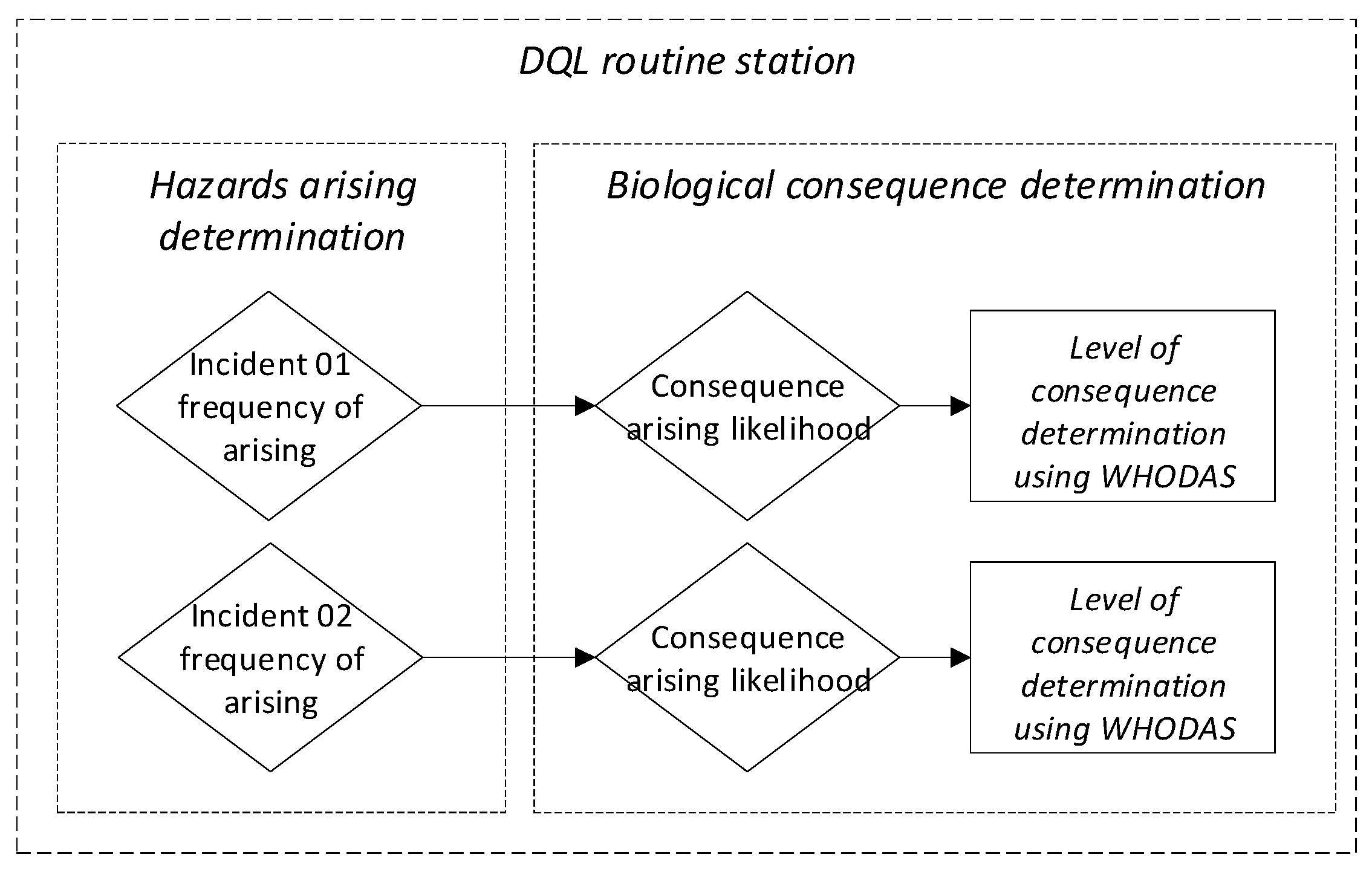

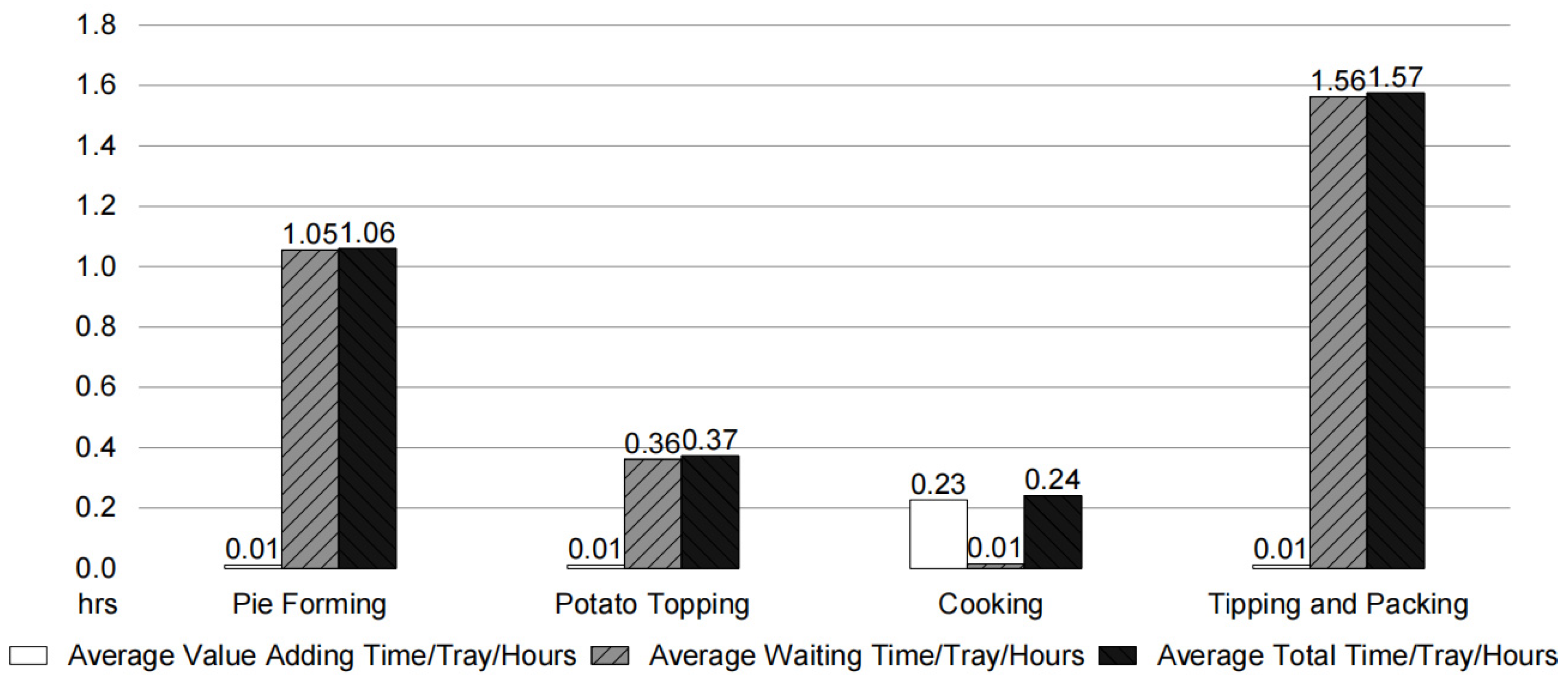
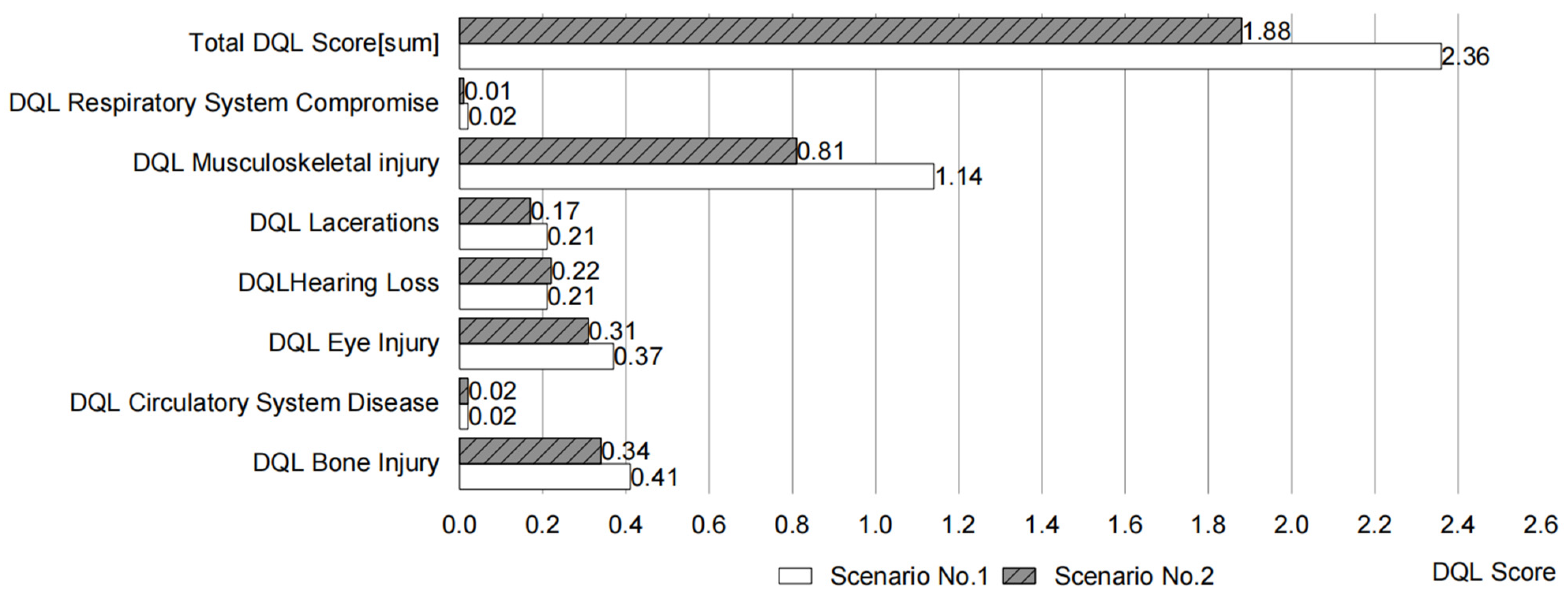
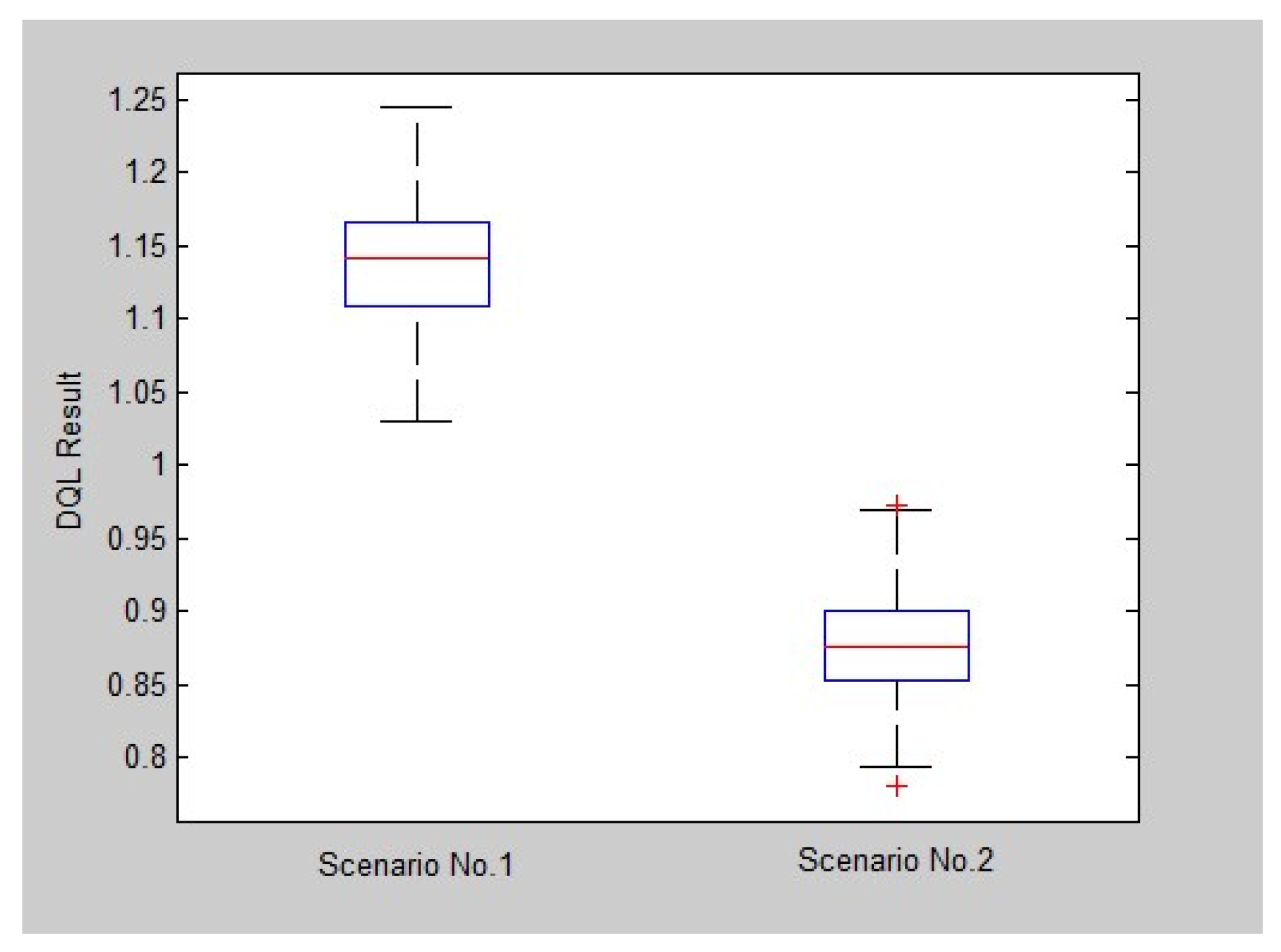
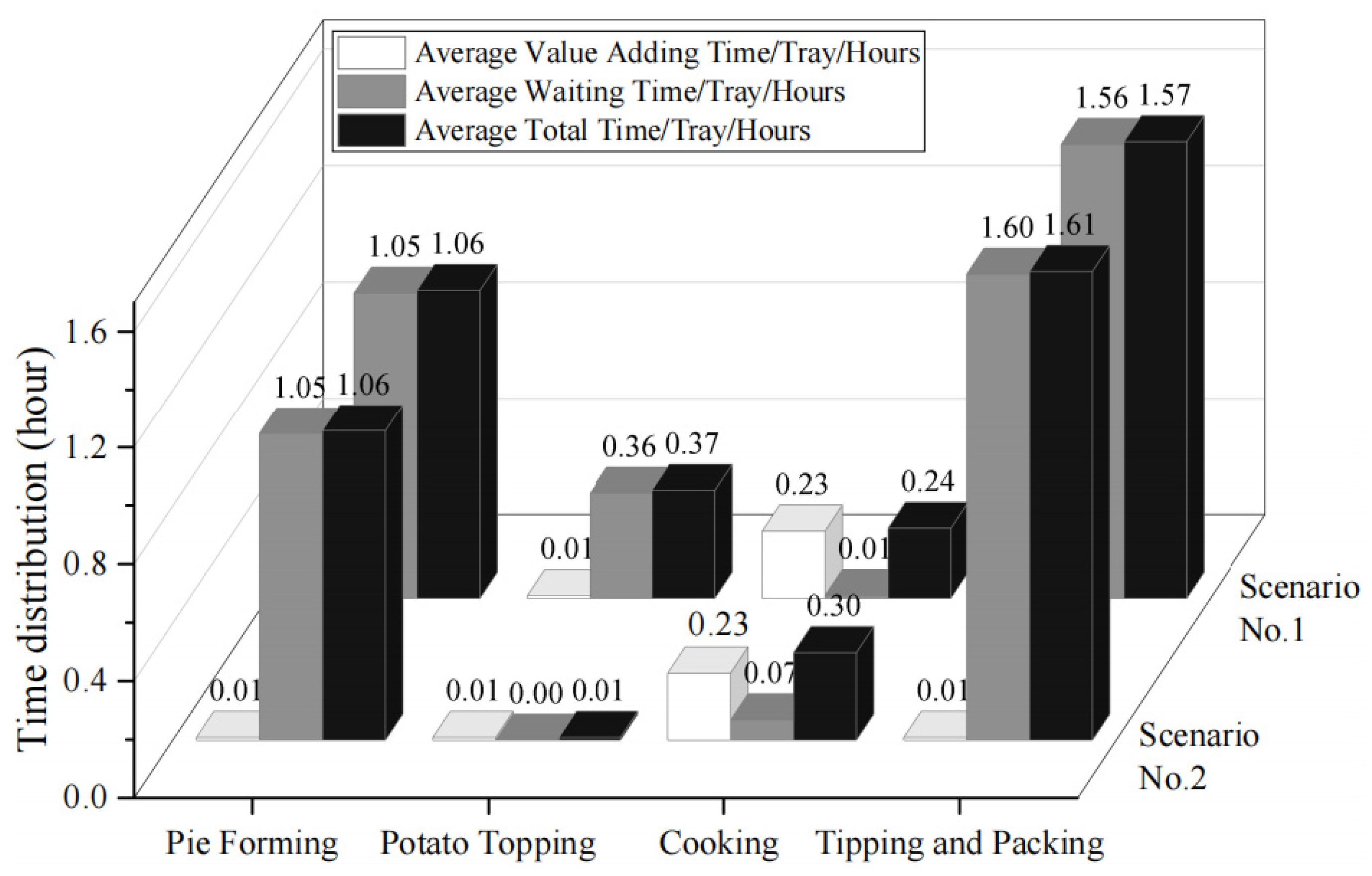
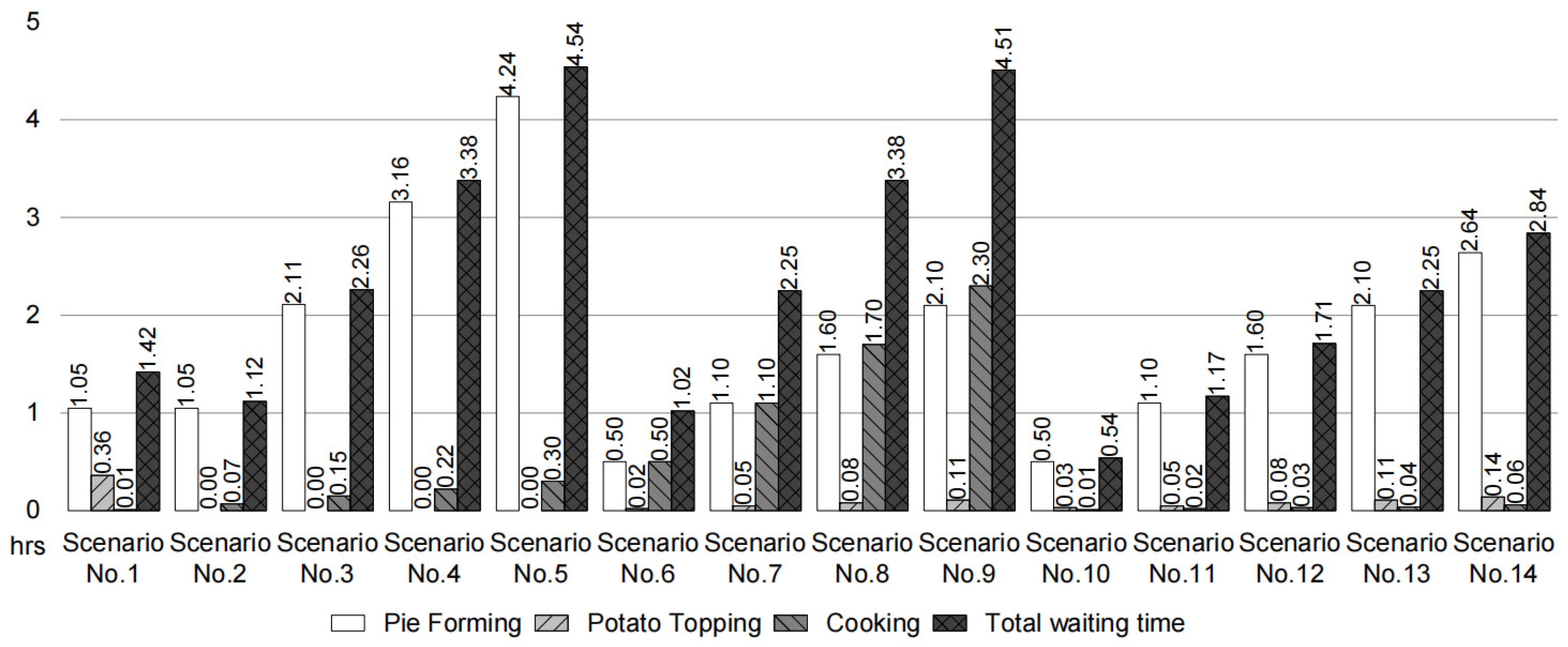
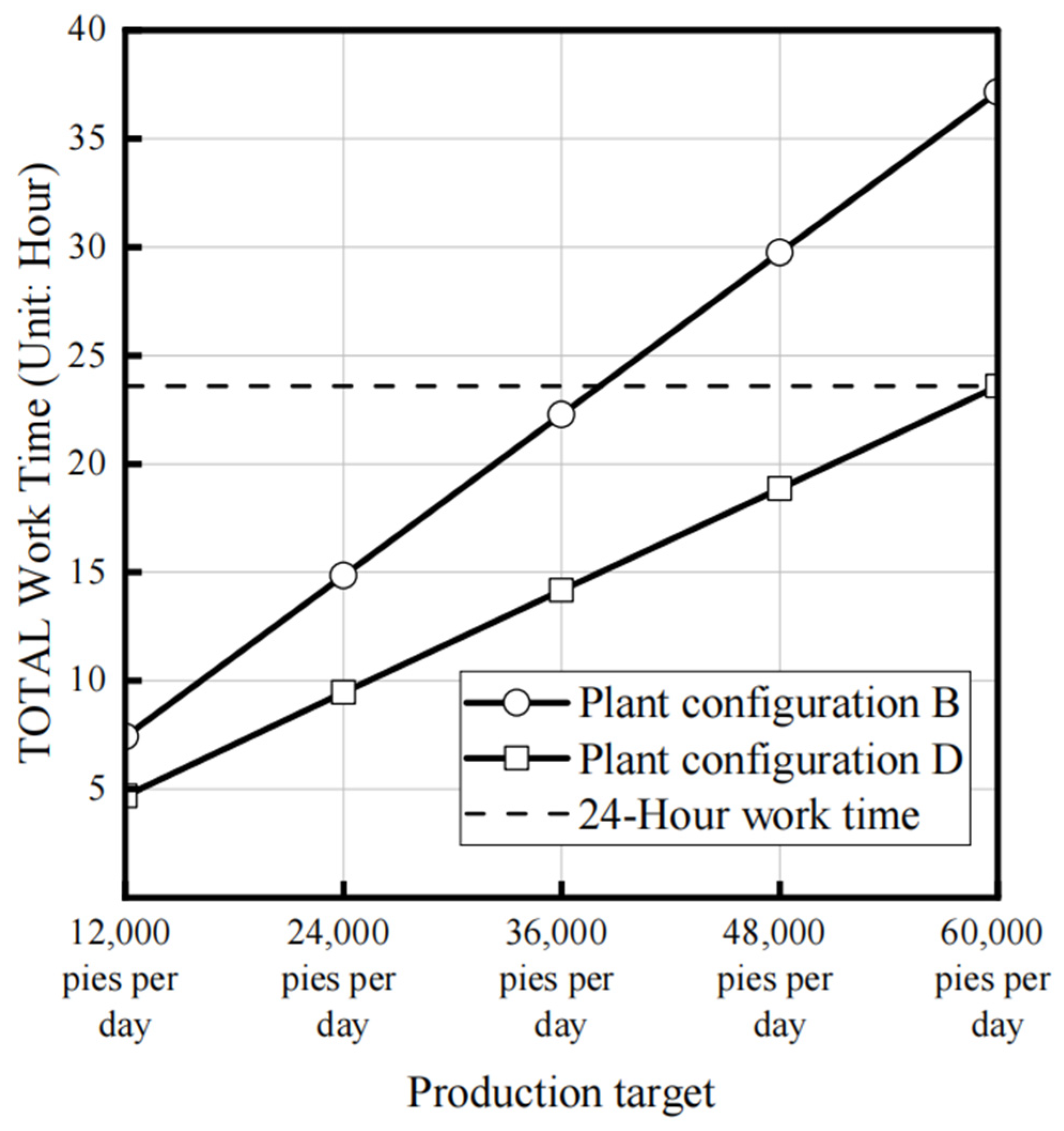
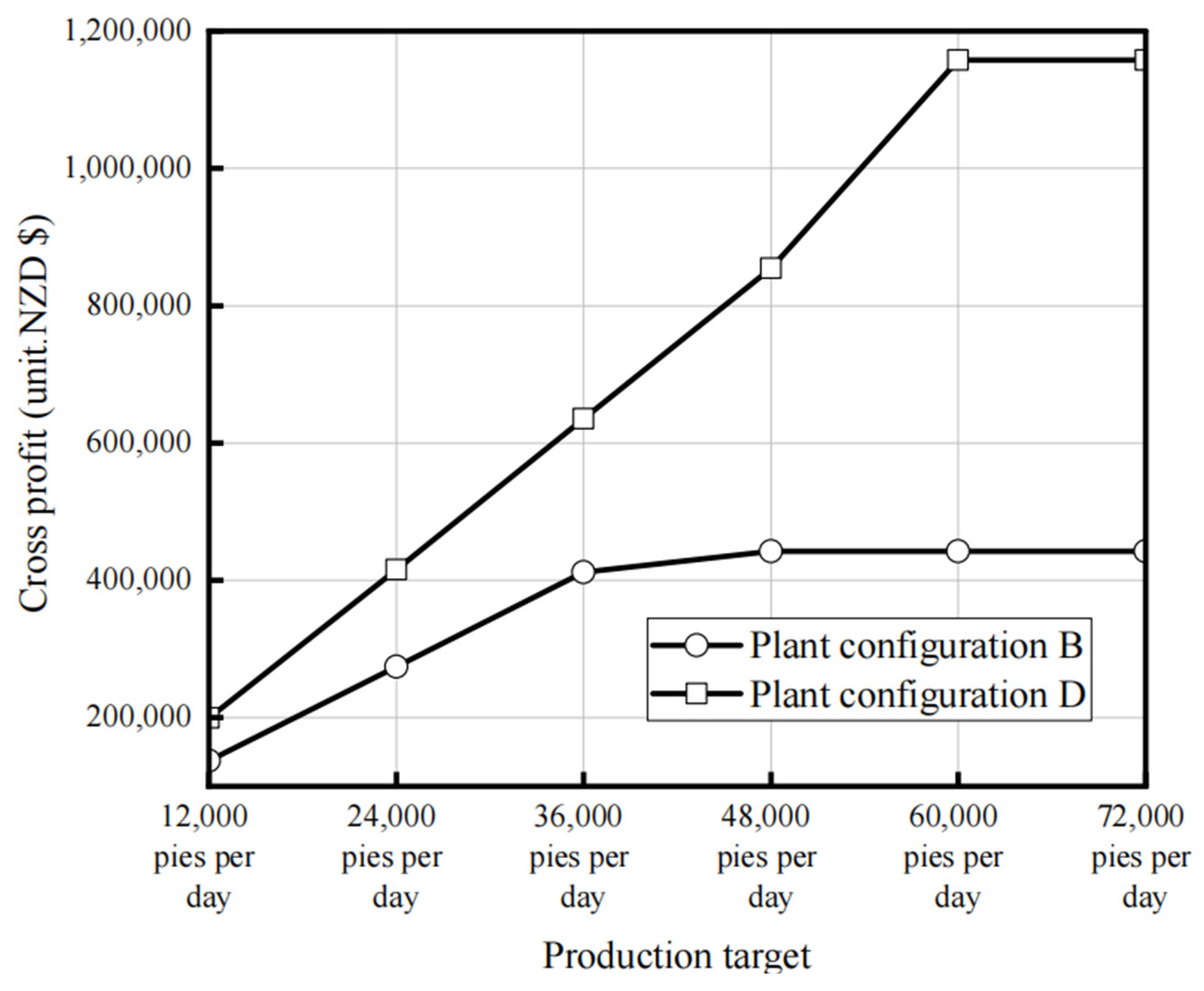
| Diminished Quality of Life Risk-Measuring Instrument | ||||||
|---|---|---|---|---|---|---|
| Hazard in the Workplace | Description of the Current State | Existing Safety Barriers | Frequency of the Incident Arising | Description of the Potential Consequence | Likelihood of the Consequence Arising | Severity of Consequence (Examined by WHODAS) |
| Dust inhalation | Exposure via pastry-making | Face mask available | 30% | Lung infection | 30% | 2.08 |
| Hit by moving objects | Trolleys and forklifts | Feet protection (wearing steel toe cap shoes) | 7% | Traumatic musculoskeletal injury | 50% | 8.33 |
| Trips and falls | Slippery floor | Regular floor clean | 60% | Traumatic musculoskeletal injury | 50% | 8.33 |
| Lacerations | 50% | 4.17 | ||||
| Bone injury | 50% | 8.33 | ||||
| Manual heavy loads and repetitive activities | Pie forming and carrying heavy potato topping bags | NA | 90% | Chronic or overuse of muscles and soft tissue injury | 60% | 8.33 |
| Uncomfortable working position | Bent neck when operating machine | NA | 60% | Chronic or overuse of muscles and soft tissue injury | 50% | 8.33 |
| Range of DQL | Level of Risk |
|---|---|
| 0–1 | Low |
| 1–3 | Moderate |
| 3–8 | High |
| Over 8 | Extreme high |
| Plant Configuration | Scenarios | Demand Loading (Pies per Day) | Number of Ovens | Number of Forming Machine | Descriptions |
|---|---|---|---|---|---|
| A | No. 1 | 12,000 | 1 | 1 | Status quo, manual potato topping |
| B | No. 2 | 12,000 | 1 | 1 | Automatic potato topping |
| No. 3 | 24,000 | 1 | 1 | Automatic potato topping | |
| No. 4 | 36,000 | 1 | 1 | Automatic potato topping | |
| No. 5 | 48,000 | 1 | 1 | Automatic potato topping | |
| C | No. 6 | 12,000 | 1 | 2 | Automatic potato topping |
| No. 7 | 24,000 | 1 | 2 | Automatic potato topping | |
| No. 8 | 36,000 | 1 | 2 | Automatic potato topping | |
| No. 9 | 48,000 | 1 | 2 | Automatic potato topping | |
| D | No. 10 | 12,000 | 2 | 2 | Automatic potato topping |
| No. 11 | 24,000 | 2 | 2 | Automatic potato topping | |
| No. 12 | 36,000 | 2 | 2 | Automatic potato topping | |
| No. 13 | 48,000 | 2 | 2 | Automatic potato topping | |
| No. 14 | 60,000 | 2 | 2 | Automatic potato topping |
| Plant Configuration | Machine Arrangement | Production Capacity | Capital Implications for Volume Growth | Labor Implications for Volume Growth |
|---|---|---|---|---|
| B | One pie-forming machine and one oven | 38,741 pies per day | None | Extra workers required, to be recruited for different work shifts. |
| D | Two pie-forming machines and two ovens | 60,225 pies per day | Requirement to purchase one oven and one pie-forming machine. | Extra workers required, to be recruited for different work shifts. |
Publisher’s Note: MDPI stays neutral with regard to jurisdictional claims in published maps and institutional affiliations. |
© 2022 by the authors. Licensee MDPI, Basel, Switzerland. This article is an open access article distributed under the terms and conditions of the Creative Commons Attribution (CC BY) license (https://creativecommons.org/licenses/by/4.0/).
Share and Cite
Ji, Z.; Pons, D.; Su, Z.; Lyu, Z.; Pearse, J. Integrating Occupational Health and Safety Risk and Production Economics for Sustainable SME Growth. Sustainability 2022, 14, 14565. https://doi.org/10.3390/su142114565
Ji Z, Pons D, Su Z, Lyu Z, Pearse J. Integrating Occupational Health and Safety Risk and Production Economics for Sustainable SME Growth. Sustainability. 2022; 14(21):14565. https://doi.org/10.3390/su142114565
Chicago/Turabian StyleJi, Zuzhen, Dirk Pons, Zhouyang Su, Zichong Lyu, and John Pearse. 2022. "Integrating Occupational Health and Safety Risk and Production Economics for Sustainable SME Growth" Sustainability 14, no. 21: 14565. https://doi.org/10.3390/su142114565





